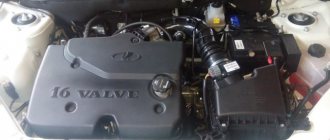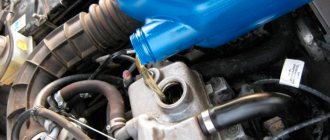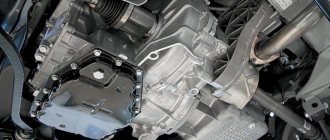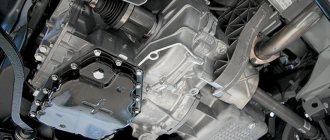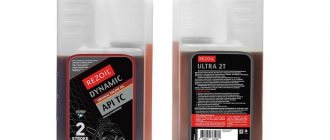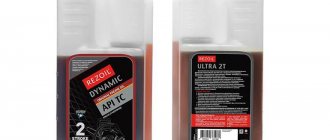What kind of lubricant is poured into the Lada Largus engine
To determine the type of oil that is poured into the Lada power unit, you need to use the standards offered by the manufacturer in the instructions. For example, for those engines designed for the environmental classes Euro 3 and Euro 4, lubricants with a domestic index are chosen:
- AAI-003 B5;
- AAI-003 B6.
If the lubricant is from a European plant, then when choosing, look at the following indices:
- API SL\SM\SN;
- ACEA A1\A2\A3\A5.
In addition to environmental standards, the level of viscosity is taken into account. Experienced mechanics recommend compounds such as:
- 0W40;
- 5W40;
- 5W30.
To determine more precisely which oil is best to use, you also need to pay attention to the area where the car is operated. For example, in cold regions a less viscous lubricant is poured, but in hot regions of Russia it is more viscous.
Lubricant selection
What kind of engine oil should I fill in Lada Largus? It can be from different brands, but must strictly comply with the manufacturer’s specifications. The requirements for the 16-valve K4M engine are as high as possible. It is better to fill in the engine oil that is used at the factory when the car was produced.
Until recently, during the first refueling, ELF SOLARIS RNX 5W30 was poured into the engine. Before this there was LUKOIL Genesis RN 5W40. The latest official information from the manufacturer states: the first filling is carried out with ELF EXCELLIUM NF 5W40 lubricant. As you can see, in both last cases the oil characteristics are 5W40, which is what needs to be taken as the basis for further operation.
Please note that 5W30 oil is less viscous than 5W40. Renault advises refilling a 16 valve engine with ELF EVOLUTION SXR 5W40. But for an 8-valve engine, a 5W30 oil change is recommended.
This is due to the fact that the more viscous 5W40 is better suited to hydraulic valve compensators. Therefore, whatever the lubricant is, it must have such characteristics.
There is no consensus among car enthusiasts regarding 16-valve engines. AvtoVAZ also does not have a clear position on this issue. Its first digit depends on the operating temperature: 0, 5, 10 or 15. For low temperatures from -30°C you need to use 0W, for moderately low temperatures (from -25°C) - 5W, etc. For all of the above cases a viscosity of 30, 40 or even 50 is required. In the presented video you can hear all the explanations why 40 or 50 cannot be poured into an engine designed for a lubricant viscosity of 30, even if it already has a good mileage.
The properties of the lubricant must comply with API SL/ API SM/ API SN. Requirements for the ash content of oil in a 16-valve engine are ASEA A1/ ASEA A2/ ASEA A3/ ASEA A5. The brands are not named, that is, you can pour in the motor oil that you subjectively like best.
Now there is a new, most suitable modification on sale - ELF EVOLUTION 900 SXR 5W40. Surely it is produced with other parameters in terms of temperature and viscosity. How much lubricant should I buy?
What original oil is poured into the Lada Largus engine
Original oils supplied by the Rosneft plant have an optimal ratio of additives and an adequate price. Original lubricants from Rosneft:
- Lada Professional 5 W40;
- Lada Ultra 5 W40.
AvtoVAZ poured the following oils into the vehicle engine:
- Shell Helix HX7 5W 40;
- Lukoil Lux 5 W 30.
Attention! Experienced mechanics recommend changing the lubricant in the power unit after 7,000 kilometers. Since the cleaning properties of modern lubricants begin to decrease after 5,000 kilometers. Together with the engine oil, the filter devices in the engine are changed from the factory.
All information on choosing engine oil for Lada Largus
When the production of K4M motors was localized, the plant was first supplied with one material - SHELL PC 1448, 0W30. Then barrels with another material were noticed - LUKOIL Genesis RN 5W40. According to official information, the engine is filled with ELF SOLARIS RNX oil. The latter belongs to the 5W30 class.
The most expensive material for refilling K4M
By analyzing all the information, you can choose which oil to pour into the Lada Largus engine with 16 valves. Are there any other options:
- Before localization, it was stated that K4M engines were filled with SHELL PC 1021 oil (viscosity was not specified);
- Answer received from the support service: the first filling material for all Largus engines is ELF EXCELLIUM NF 5W40 oil. The date of receipt of the response is December 2, 2014.
So there are five different brands named here. And all this is the first refueling!
Renault company recommendations (motor oil regulations)
It's no secret that the Lada Largus is a redesigned Renault Logan station wagon. When buying a Renault car, everything looks simpler than with Largus:
- From the factory, the K4M engine is filled with ELF Excellium LDX oil. Its viscosity is 5W40 (not 5W30);
- ELF Evolution SXR with a viscosity of 5 would be recommended . 5W30 is for 8 valves.
oil with the index “ W30 ” will be less viscous than “ W40 ”. And for hydraulic compensators you need just the second one.
You can follow Reno's recommendations and everything will be fine.
The owners themselves are still arguing about what kind of oil to pour into the Lada Largus engine - 5W/30 or 5W/40. And if we talk about 16 valves, there is no consensus yet.
Subtotal
All options for “factory” refueling:
- SHELL: brand PC 1448 (0W30), PC 1021 (presumably 0W30);
- ELF: brand SOLARIS RNX (5W30), EXCELLIUM NF (5W40), EVOLUTION SXR (5W40);
- Russian industry: LUKOIL GENESIS RN (5W40).
Renault company recommendations (for replacement): ELF EVOLUTION SXR (5W40).
What kind of oil does VAZ recommend for a 16-valve valve?
Let's see what they say in the instruction manual. Brands and marks are not named here.
Instructions for Lada Largus
Only viscosity classes are given, as well as quality classes and ash content (ACEA).
The choice is made based on the conditions: class “0W” is suitable for low temperatures, and “5W” is suitable for moderately low temperatures. The choice between “W30” and “W40” has already been discussed above.
The list does not include 0W50 viscosity grade. Materials that meet such high requirements simply do not exist. The quality classes indicated are standard, and the “best” of them is API SN. Well, the “ash content” should be “medium” - all ACEA class names begin with the letter A.
The choice of motorists themselves
The reader has probably already found out what kind of oil to pour into the Lada Largus engine. Six different options were named. There are other, “less standard” replacements:
- Lukoil Lux Synthetic SN, 5W40;
- SHELL Helix Ultra, 5W40 (many fakes);
- ELF EVOLUTION 900 FT, 0W30;
- TEXACO Havoline Energy, 5W30;
- Nissan Oil, 5W40 (factory option for the Almera sedan);
- GM Dexos 2, 5W30.
By the way, the new name for the EVOLUTION SXR is EVOLUTION 900 SXR! Don't look for something that doesn't exist.
ELF EVOLUTION 900 SXR packaging
The question remains, what is the volume of the engine crankcase? Answer:
- The crankcase is designed for 5 liters of oil;
- Filling volume if the filter is not changed – 4.6 liters;
- When replacing with a filter, add another 200-250 ml.
Now the reader knows how much oil to pour into the Lada Largus engine, whose 16 valves require as much as 5 liters of lubricant! The refueling volume will be less than 5. Read more about the engine models on the Lada Largus in the article: what engines are installed on the Lada Largus.
Lubricant for gearbox Lada Largus
After 90,000 thousand kilometers, car owners first think about what gear oil to pour into the Largus gearbox. Experienced mechanics recommend not to pour the same lubricant into the mechanics, automatic transmission and variator. For different types of gearboxes, lubricant intended only for it is used.
For your information! Unfortunately, many car owners only have a manual transmission installed in Lada Largus. The automaker tried to install an automatic transmission on the car, but the car with automatic transmission never entered mass production.
Although the manufacturer claims that the oil in the box does not need to be changed, experienced mechanics advise regularly replacing it after 90 thousand kilometers. If the car is used in difficult conditions, then the replacement period is reduced to 60,000 km.
When choosing mechanical oil, you need to pay attention to the viscosity and specification. The SAE marking indicates low temperature and high temperature characteristics. In areas with a temperature of at least 26 degrees with a minus sign, lubricant with the index 80W is poured into the manual transmission. Oil with a specification of 75W is poured in regions with temperatures not lower than 40.
The most commonly used oil that is poured into the Lada Largus box is Elf Tranself NFJ 75W-80. The lubricant belongs to class GL 4+. It is approved by companies such as AvtoVAZ and Renault. Oil is added from the factory. But many motorists replace it with analogues. Experienced mechanics advise that when replacing the original lubricating fluid with an analogue, completely drain the used oil and refill with fresh oil.
As analogues, choose the one that is suitable in terms of viscosity and standard. It is not recommended to change mineral to synthetic and vice versa.
Which is better, SAE W30 or W40 - video explanation
Every caring owner is burdened by the issue of trouble-free operation of the engine. One of the main conditions for such success is the timely replacement of high-quality motor oil; it is also important to know what kind of oil to fill. In the Lada Largus engine, the lubricant must be replaced after 15 thousand km.
km run. During this period, the majority of owners of this station wagon have a moment of truth associated with the choice of a quality product. As you know, oil with excellent quality indicators is capable of keeping engine parts in “good health” and providing them with the service life declared by the manufacturer.
When owners of a Lada Largus with an 8-valve and 16-valve engine skimp on oil and fill in with a product of unknown origin, they deliberately doom the engine to failure. If the car is also under warranty, then this approach may lead to deprivation of the right to this preferential service.
Towbar for Renault SanderoRenault Duster cross-country ability video
What is important besides changing the lubricant in the engine and manual transmission
Many car enthusiasts do not like to look under the hood before changing the lubricant. The fact is that during operation, rubber gaskets and seals can harden and leak oil. As a result, lubricant loss begins in these devices. The level decreases, which leads to strange behavior of the car on the roads and ultimately to major repairs.
To prevent this from happening, experienced mechanics advise:
- every 5,000 kilometers check the lubricant level in the engine;
- Every 30,000 kilometers, check the oil level in the manual transmission.
Such simple measures will save the car owner from wasting money. If necessary, it is recommended to add oil to the gearbox or power unit. The engine and manual transmission are pre-serviced. A technical inspection is needed to detect faults that lead to loss of lubricant.
What harms the normal long-term operation of the rubber parts of the engine and mechanics:
- daily delays in traffic jams. The oil in the power unit and gearbox heats up and then cools down; the oil seals expand and contract at a constant frequency, which leads to their wear. And the lubricant itself quickly loses its properties in this case;
- starting the engine cold;
- Frequent travel over short distances. The liquid does not have time to really warm up. Condensation forms. This happens very often in winter.
And condensation dilutes the lubricant, and it loses its protective properties.
Engine oil change period Lada Vesta Cross
The frequency of changing engine oil for a Lada Vesta Cross car is every 10 thousand km or once a year, depending on how quickly the oil deteriorates. It is recommended to carry out a timely check of the condition of the fluid, and if signs of deterioration in the quality of the oil are detected (turbidity, the presence of wear products in the form of sediment, a burning smell, insufficient level), it must be changed every 6-7 thousand km. As a rule, this is usually relevant for urban use, when the car is stuck in traffic jams most of the time. In this case, sudden starts and braking are possible, leading to overheating of the engine.
Top 5. Shell Helix Ultra
139 reviews from resources taken into account: Yandex.Market, Otzovik
- Nomination
Better frost resistance Shell Helix ultra 5w-40 engine oil loses viscosity only at -45˚C, which reduces wear and facilitates cold starts in harsh temperature conditions. The closest competitor, ELF Evolution 900 SXR, is inferior in this indicator by 3 ˚C.
- Characteristics
- Average price (4 l): 2419 rub.
- API: SN
- ACEA: A3/B3, A3/B4
- SAE: 5W-40
- Pour point, ˚C: -45
Country: UK
Drivers who have experience operating a LADA Largus with a K4M or K7M engine in the northern regions speak positively about this motor oil. The synthetic product is made from natural gas using GTL technology, is highly pure and leads to a noticeable reduction in fuel consumption. The absence of impurities has made it possible to slow down the aging of the lubricant to a minimum - many safely drive 15 thousand km on it. Another reason to fill in Shell Helix Ultra oil is its excellent cleaning ability, which allows you to gently rid the internal combustion engine of accumulated deposits in just 3-4 changes. Owners of Largus with 16 valves only complain that it is almost impossible to find the product in 5-liter packages.
Advantages and disadvantages
- Low tendency to evaporate
- Accelerated engine warm-up
- Wear and corrosion protection
- There is no five-liter packaging
Mechanical damage
The next point of troubleshooting will be a visual check of the hoses of the car's braking system: there should be no signs of leakage at the hose connections and on the car parts.
Often the cause may be a poorly tightened screw connection. You should also check the places where the pipes are attached to the cylinders on the brake discs: if this problem is detected, use an 8 mm wrench to tighten all the nuts that secure the pipes.
All hoses must be intact, without cracks or kinks. If this malfunction is detected, such hoses must be replaced with new ones. It is also worth paying attention to the condition of the master cylinder gasket - there should also be no signs of leakage or breakage on it.
The degree of wear of brake pads and brake discs also plays a special role. There should be no signs of wear on these system elements; the pads should not be worn down to metal. All these elements must be changed in a timely manner.

